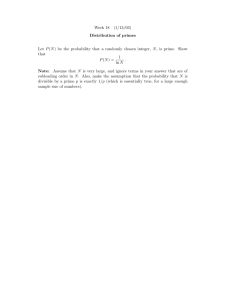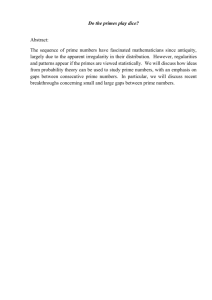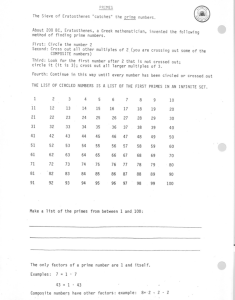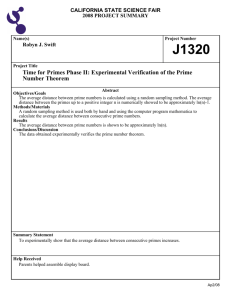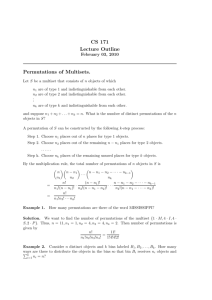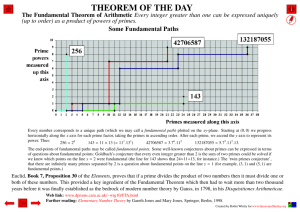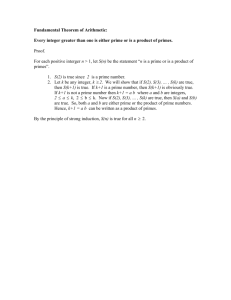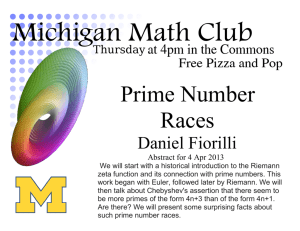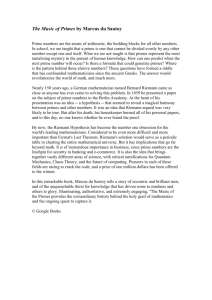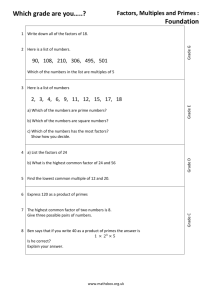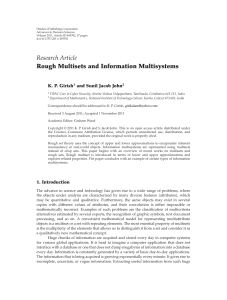Emulating Primality with Multiset Representations of Natural Numbers
advertisement
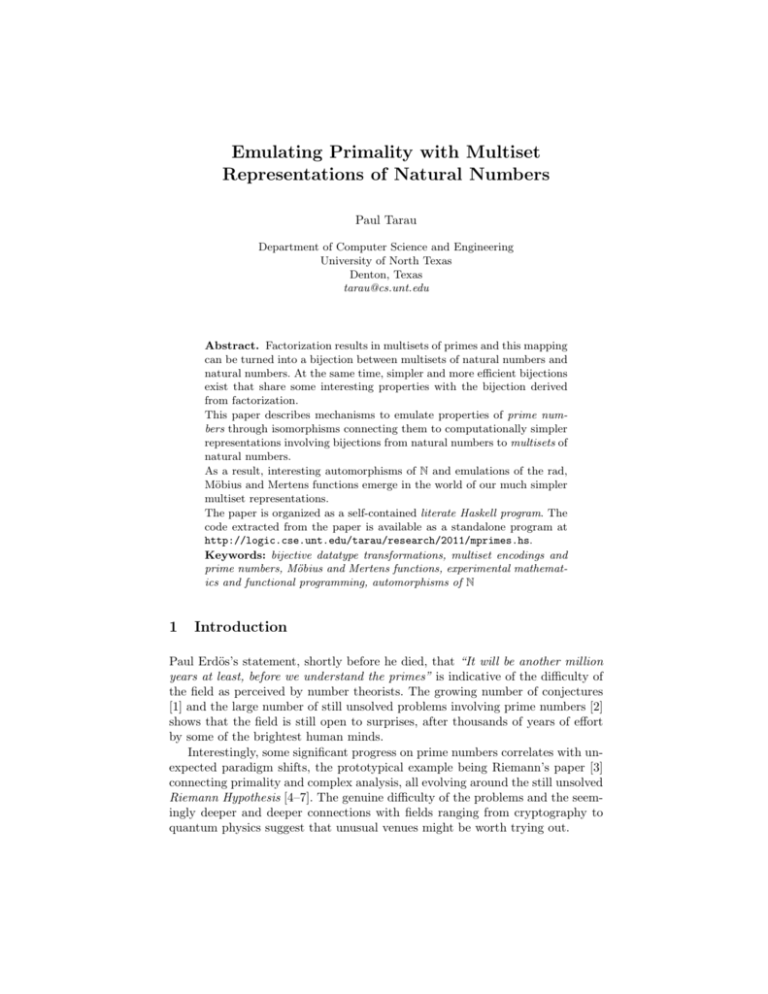
Emulating Primality with Multiset
Representations of Natural Numbers
Paul Tarau
Department of Computer Science and Engineering
University of North Texas
Denton, Texas
tarau@cs.unt.edu
Abstract. Factorization results in multisets of primes and this mapping
can be turned into a bijection between multisets of natural numbers and
natural numbers. At the same time, simpler and more efficient bijections
exist that share some interesting properties with the bijection derived
from factorization.
This paper describes mechanisms to emulate properties of prime numbers through isomorphisms connecting them to computationally simpler
representations involving bijections from natural numbers to multisets of
natural numbers.
As a result, interesting automorphisms of N and emulations of the rad,
Möbius and Mertens functions emerge in the world of our much simpler
multiset representations.
The paper is organized as a self-contained literate Haskell program. The
code extracted from the paper is available as a standalone program at
http://logic.cse.unt.edu/tarau/research/2011/mprimes.hs.
Keywords: bijective datatype transformations, multiset encodings and
prime numbers, Möbius and Mertens functions, experimental mathematics and functional programming, automorphisms of N
1
Introduction
Paul Erdös’s statement, shortly before he died, that “It will be another million
years at least, before we understand the primes” is indicative of the difficulty of
the field as perceived by number theorists. The growing number of conjectures
[1] and the large number of still unsolved problems involving prime numbers [2]
shows that the field is still open to surprises, after thousands of years of effort
by some of the brightest human minds.
Interestingly, some significant progress on prime numbers correlates with unexpected paradigm shifts, the prototypical example being Riemann’s paper [3]
connecting primality and complex analysis, all evolving around the still unsolved
Riemann Hypothesis [4–7]. The genuine difficulty of the problems and the seemingly deeper and deeper connections with fields ranging from cryptography to
quantum physics suggest that unusual venues might be worth trying out.
A number of breakthroughs in various sciences involve small scale emulation
of complex phenomena. Common sense analogies thrive on our ability to extrapolate from simpler (or, at least, more frequently occurring and better understood)
mechanisms to infer surprising properties in a more distant ontology.
Prime numbers exhibit a number of fundamental properties of natural phenomena and human artifacts in an unusually pure form. For instance, reversibility
is present as the ability to recover the operands of a product of distinct primes.
This relates to the information theoretical view of multiplication [8] and it suggests investigating connections between combinatorial properties of multisets
and operations on multisets and multiplicative number theory.
With such methodological hints in mind, this paper will explore mappings
between multiset encodings and prime numbers. It is based on our data type
transformation framework connecting most of the fundamental data types used
in computer science with a groupoid of isomorphisms [9–11].
The paper is organized as follows. Section 2 revisits the well-known connection between multisets and primes using a variant of Gödel’s encoding [12].
Section 3 describes our computationally efficient multiset encoding. Based on
these encodings, section 4 explores the analogy between multiset decompositions and factoring and describes a multiplicative monoid structure on multisets
that “emulates” properties of the monoid induced by ordinary multiplication as
well as generic definitions in terms of multiset encodings of the rad, Möbius and
Mertens functions. Section 5 describes automorphisms of N derived from alternative multiset encodings. Section 6 overviews some related work and section 7
concludes the paper.
We organize our literate programming code as a Haskell module, relying only
on the List library module:
module MPrimes where
import Data.List
2
2.1
Encoding finite multisets with primes
Ranking/unranking of sets and finite sequences
First, we define an isomorphism between sets and finite sequences (the Hub of the
groupoid of isomorphisms) as described in [9] (also in the Appendix), resulting
in the Encoder set:
set2list xs = shift_tail pred (mset2list xs) where
shift_tail _ [] = []
shift_tail f (x:xs) = x:(map f xs)
list2set = (map pred) . list2mset . (map succ)
set :: Encoder [N]
set = Iso set2list list2set
We can rank/unrank a set represented as a list of distinct natural numbers
by observing that it can be seen as the list of exponents of 2 in the number’s
base 2 representation.
nat_set = Iso nat2set set2nat
nat2set n | n ≥ 0 = nat2exps n 0 where
nat2exps 0 _ = []
nat2exps n x = if (even n) then xs else (x:xs) where
xs=nat2exps (n ‘div‘ 2) (succ x)
set2nat ns = sum (map (2^) ns)
The resulting Encoder is:
nat :: Encoder N
nat = compose nat_set set
2.2
Encoding Multisets
Multisets [13] are unordered collections with repeated elements. Non-decreasing
sequences provide a canonical representation for multisets of natural numbers.
The mapping between finite multisets and primes described in this section
goes back to Gödel’s arithmetic encoding of formulae [12, 14]. A factorization of
a natural number is uniquely described as a multiset of primes. We can use the
fact that each prime number is uniquely associated to its position in the infinite
stream of primes to obtain a bijection from multisets of natural numbers to natural numbers. This mapping is the same as the prime counting function traditionally denoted π(n), which associates to n the number of primes smaller or equal
to n, restricted to primes. It is provided by the function to prime positions
defined in Appendix. The function nat2pmset maps a natural number to the
multiset of prime positions in its factoring1 .
nat2pmset 1 = []
nat2pmset n = to_prime_positions n
Clearly the following holds:
Proposition 1 p is prime if and only if its decomposition in a multiset given
by nat2pmset is a singleton.
The function pmset2nat (relying on from in and primes defined in Appendix)
maps back a multiset of positions of primes to the result of the product of the
corresponding primes.
pmset2nat [] = 1
pmset2nat ns = product (map (from_pos_in primes . pred) ns)
1
In contrast to [9], we will assume that our mappings are defined on N+ = N − {0}
rather than N.
The operations nat2pmset and pmset2nat form an isomorphism that, using the combinator language defined in [9] (and summarized in the Appendix
to ensure that this paper is fully self-contained) provides any-to-any encodings
between various data types. This gives the Encoder pmset for prime encoded
multisets as follows:
pmset :: Encoder [N]
pmset = compose (Iso pmset2nat nat2pmset) nat
working as follows:
∗MPrimes> as pmset nat 2010
[1,2,3,19]
∗MPrimes> as nat pmset [1,2,3,19]
2010
For instance, as the factoring of 2010 is 2 ∗ 3 ∗ 5 ∗ 67, the list [1,2,3,19] contains
the positions of the factors, starting from 1, in the sequence of primes.
3
A bijection between finite multisets and natural
numbers
We will now define ranking/unranking functions for multisets i.e. bijective mappings to/from natural numbers. While finite multisets and sequences representing finite functions share a common representation [N ], multisets are subject
to the implicit constraint that their ordering is immaterial. This suggest that
a multiset like [4, 4, 1, 3, 3, 3] could be represented canonically as sequence by
first ordering it as [1, 3, 3, 3, 4, 4] and then computing the differences between
consecutive elements i.e. [x0 , x1 . . . xi , xi+1 . . .] → [x0 , x1 − x0 , . . . xi+1 − xi . . .].
This gives [1, 2, 0, 0, 1, 0], with the first element 1 followed by the increments
[2, 0, 0, 1, 0], as implemented by mset2list:
mset2list xs = zipWith (-) (xs) (0:xs)
It is now clear that incremental sums of the numbers in such a sequence return
the original set as implemented by list2mset:
list2mset ns = tail (scanl (+) 0 ns)
Note that canonical representation (i.e. being sorted) is assumed for set and
multisets.
The isomorphism between finite multisets and finite functions (seen as finite
sequences in N) is specified with two bijections mset2list and list2mset.
mset0 :: Encoder [N]
mset0 = Iso mset2list list2mset
The resulting isomorphism mset0 can be applied by using its two components
mset2list and list2mset directly.
∗MPrimes> mset2list [1,3,3,3,4,4]
[1,2,0,0,1,0]
∗MPrimes> list2mset [1,2,0,0,1,0]
[1,3,3,3,4,4]
Equivalently, following [9] (see also summary in Appendix), it can be expressed
generically by using the “as” combinator:
∗MPrimes> as list mset0 [1,3,3,3,4,4]
[1,2,0,0,1,0]
∗MPrimes> as mset0 list [1,2,0,0,1,0]
[1,3,3,3,4,4]
The combinator “as” derives automatically any-to-any encodings, by routing
through the appropriate one-to-one transformations (see [9] and the Appendix).
As a result, we obtain “for free” a bijection from N to finite multisets of elements
of N :
∗MPrimes> as mset0 nat 2011
[0,0,1,1,2,2,2,2,2]
∗MPrimes> as nat mset0 it
2011
We will need one small change to convert this into a mapping on N+ .
nat2mset1 n=map succ (as mset0 nat (pred n))
mset2nat1 ns=succ (as nat mset0 (map pred ns))
mset :: Encoder [N]
mset = compose (Iso mset2nat1 nat2mset1) nat
The resulting mapping, like pmset, now works on N+ .
∗MPrimes> as mset nat 2012
[1,1,2,2,3,3,3,3,3]
∗MPrimes> as nat mset it
2012
∗MPrimes> map (as mset nat) [1..7]
[[],[1],[2],[1,1],[3],[1,2],[2,2]]
Note that these mappings work in linear time and space in the bitsize of the
numbers [15]. On the other hand, as prime number enumeration and factoring
are involved in the mapping from numbers to multisets, the encoding described
in section 2 is intractable for all but small values.
4
Exploring the analogy between multiset decompositions
and factoring
As natural numbers can be uniquely represented as multisets of prime factors
and, independently, they can also be represented as a multiset with the Encoder
mset (described in section 3), the following question arises naturally:
Can the computationally efficient encoding mset help emulate some properties
of the the difficult to reverse factoring operation?
4.1
A multiset analog to multiplication
The first step is to define an analog of the multiplication operation in terms
of the computationally easy multiset encoding mset. Clearly, it makes sense
to take inspiration from the fact that factoring of an ordinary product of two
numbers can be computed by concatenating the multisets of prime factors of
its operands. We use the combinator borrow from and the sorted concatenation
sortedConcat operations (see Appendix) to express this:
mprod = borrow_from mset sortedConcat nat
Proposition 2 hN + , mprod, 1i is a commutative monoid i.e. mprod is defined
for all pairs of natural numbers and it is associative, commutative and has 1 as
an identity element.
Proof. After rewriting the definition of mprod as the equivalent:
mprod_alt n m = as nat mset
(sortedConcat (as mset nat n) (as mset nat m))
the proposition follows immediately from the associativity of the concatenation
operation and the order independence of the multiset encoding provided by mset.
t
u
Here are a few examples showing that mprod has properties similar to ordinary
multiplication:
∗MPrimes> mprod 41 (mprod 33 38) == mprod (mprod 41 33) 38
True
∗MPrimes> mprod 33 46 == mprod 46 33
True
∗MPrimes> mprod 1 712 == 712
True
Given the associativity of mprod, it makes sense to define the product of a list
of numbers as
mproduct ns = foldl mprod 1 ns
Note also that any multiset encoding of natural numbers can be used to
define a similar commutative monoid structure. In the case of pmset we obtain:
pmprod n m = as nat pmset
(sortedConcat (as pmset nat n) (as pmset nat m))
This brings us back to observe that:
Proposition 3 hN, pmprod, 1i is a commutative monoid i.e. pmprod is defined
for all pairs of natural numbers and it is associative, commutative and has 1 as
an identity element.
Unsurprisingly, this is the case indeed as one can deduce immediately from the
definition of pmprod that, on N+ :
pmprod ≡ ∗
(1)
As obvious as this equivalence is, note that computing * is easy, while computing
pmprod involves factoring which is intractable for large values.
Experimentally (including very large random integers), mprod x y ≤ pmprod
x y, leading us to:
Conjecture 1 mprod x y = x ∗ y if and only if ∃n ≥ 0 such that x = 2n or
y = 2n . Otherwise, mprod x y < x ∗ y.
Fig. 1 shows the self-similar landscape generated by the function (mprod x y)
/ (x*y) for values of x,y in [1..128].
Fig. 1. Ratio between mprod and product
We can derive an exponentiation operation as a repeated application of
mprod:
mexp n 1 = n
mexp n k = mprod n (mexp n (k-1))
Let us first observe that the ordinary exponent and our emulated variant
correlate as follows:
∗MPrimes> map (λx→mexp 2 x) [1..8]
[2,4,8,16,32,64,128,256]
∗MPrimes> map (λx→2^x) [1..8]
[2,4,8,16,32,64,128,256]
∗MPrimes> map (λx→mexp x 2) [1..16]
[1,4,7,16,13,28,31,64,25,52,55,112,61,124,127,256]
∗MPrimes> map (λx→x^2) [1..16]
[1,4,9,16,25,36,49,64,81,100,121,144,169,196,225,256]
Fig. 2 shows that values for mexp x 2 follow from below those of the x2 function
and that equality only holds when x is a power of 2.
Fig. 2. Square vs. mexp n 2
4.2
Multiset analogues for div, gcd and lcd
Besides the connection with products, natural mappings worth investigating
are the analogies between multiset intersection and gcd of the corresponding
numbers or between multiset union and the lcm of the corresponding numbers.
Assuming the definitions of multiset operations provided in the Appendix, one
can define:
mgcd :: N → N → N
mgcd = borrow_from mset msetInter nat
mlcm :: N → N → N
mlcm = borrow_from mset msetUnion nat
mdivisible :: N→N→Bool
mdivisible n m = mgcd n m==m
mdiv :: N → N → N
mdiv = borrow_from mset msetDif nat
mexactdiv :: N → N → N
mexactdiv n m | mdivisible n m = mdiv n m
and note that properties similar to usual arithmetic operations hold:
4.3
mprod(mgcd x y)(mlcm x y) ≡ mprod x y
(2)
mexactdiv(mprod x y) y ≡ x
(3)
mexactdiv(mprod x y) x ≡ y
(4)
Multiset primes
A remarkable algebraic property of N is that the lattice structure defined by the
divisibility relation has an infinite antichain: the set of prime numbers. We will
now provide a simple “emulation” of primality that shares this property.
Definition 1 We say that p > 1 is a multiset-prime (or mprime shortly), if its
decomposition as a multiset is a singleton.
The following holds
Proposition 4 p > 1 is a multiset prime if and only if it is not mdivisible by
any number in [2..p − 1].
Proof. This follows immediately by observing that singleton multisets are the
first to contain a given number as the multiset [a,b] corresponds to a number
strictly larger than the numbers corresponding to multisets [a] and [b].
t
u
We are now ready to “emulate” primality in our multiset monoid by defining
is mprime (or alternatively alt is mprime) as a recognizer for multiset primes
and mprimes as a generator of their infinite stream:
is_mprime p | p >1 = 1==length (as mset nat p)
alt_is_mprime p | p>1 =
[]==[n | n←[2..p-1],p ‘mdivisible‘ n]
mprimes = filter is_mprime [2..]
Trying out mprimes gives:
∗MPrimes> take 10 mprimes
[2,3,5,9,17,33,65,129,257,513]
suggesting the following proposition:
Proposition 5 There’s an infinite number of multiset primes and they are exactly the numbers of the form 2n + 1.
Proof. The proof follows immediately by observing that the first value of as
mset nat n that contains k, is n = 2k + 1 and that numbers of that form are
exactly the numbers resulting in singleton multisets.
t
u
The following example illustrates this property.
∗MPrimes> map (as mset nat) [1..9]
[[],[1],[2],[1,1],[3],[1,2],[2,2],[1,1,1],[4]]
^^^
^^^
^^^
2+1
4+1
8+1
We can now implement faster versions of mprimes and is mprime:
mprimes’ = map (λx→2^x+1) [0..]
is_mprime’ p | p>1 = p==
last (takeWhile (λx→x ≤ p) mprimes’)
4.4
An analog to the “rad” function
Definition 2 n is square-free if each prime on its list of factors occurs exactly
once.
The rad(n) function (A007947 in [16]) is defined as follows:
Definition 3 rad(n) is the largest square-free number that divides n
Clearly, rad can be computed by factoring, then trimming multiple occurrences
with the nub library function and finally by multiplying the resulting primes
with product.
rad n = product (nub (to_primes n))
Note that rad can also be computed by trimming multiplicities in a multiset
representation of n i.e. after defining respectively
pfactors n = nub (as pmset nat n)
mfactors n = nub (as mset nat n)
we can define prad ≡ rad and its multiset equivalent mrad:
prad n = as nat pmset (pfactors n)
mrad n = as nat mset (mfactors n)
∗MPrimes> map rad [2..16]
[2,3,2,5,6,7,2,3,10,11,6,13,14,15,2]
∗MPrimes> map prad [2..16]
[2,3,2,5,6,7,2,3,10,11,6,13,14,15,2]
∗MPrimes> map mrad [2..16]
[2,3,2,5,6,3,2,9,10,11,6,5,6,3,2]
A comparison of the plots of the two functions (Fig. 3) shows that rad’s chaotic
behavior corresponds to a more regular, self-similar behavior in the case of mrad.
Fig. 3. rad(n) and mrad(n) on [2..27 − 1]
One can further explore if this “emulation” of the rad function can bring
some light on the well known connections between the rad function and the
famous abc conjecture [17].
4.5
Emulating the Möbius and Mertens functions
The Möbius function separates square free primes with even and odd number of
factors from numbers that are not square free.
if n = 1
1
if p2 divides n for some prime p
µ(n) = 0
(−1)r if n has r distinct prime factors
A generalization that parameterizes it by the type t of a multiset encoding
of natural numbers is given as follows.
mobius t n = if nub ns == ns then f ns else 0 where
ns = as t nat n
f ns = if even (genericLength ns) then 1 else -1
For t=pmset one obtains the instance corresponding to primes (sequence A008683
in [16]) while t=mset provides an instance corresponding to mprimes.
∗MPrimes> map (mobius pmset) [1..16]
[1,-1,-1,0,-1,1,-1,0,0,1,-1,0,-1,1,1,0]
∗MPrimes> map (mobius mset) [1..16]
[1,-1,-1,0,-1,1,0,0,-1,1,1,0,0,0,0,0]
Surprisingly this corresponds to the apparently identical sequences A132971 and
A085357 in [16], related to enumeration of ternary trees and infinite Fibonacci
words. We postpone exploring this connections for now, and define, in a similar
way a generalization of the Mertens function (A002321 in [16])
X
M (x) =
µ(n)
n≤x
that accumulates values of the Möbius function up to n:
mertens t n = sum (map (mobius t) [1..n])
working as follows
∗MPrimes> map (mertens pmset) [1..16]
[1,0,-1,-1,-2,-1,-2,-2,-2,-1,-2,-2,-3,-2,-1,-1]
∗MPrimes> map (mertens mset) [1..16]
[1,0,-1,-1,-2,-1,-1,-1,-2,-1,0,0,0,0,0,0]
The Mertens conjecture (disproved by Odlyzko and te Riele, [18]) states that
√
|M (n)| < n, f or n > 1
After defining
mertens2 t n = m^2 where m = mertens t n
counterex_mertens t m = [n | n←[2..m],mertens2 t n ≥ n^2]
we can show that it holds for small values for both t=mset and t=pmset
∗MPrimes> counterex_mertens pmset 1000
[]
∗MPrimes> counterex_mertens mset 1000
[]
Fig. 4 shows the more regular, fractal-like behavior of the Mertens function
derived from mset in contrast with the more chaotic and strongly oscillating
behavior of the original Mertens function derived from pmset.
Fig. 4. Mertens functions for mset and pmset
A connection between the Riemann Hypothesis, originating from a representation of the inverse of the Riemann ζ function as
∞
X
1
µ(n)
=
ζ(s) n=1 ns
has lead to an equivalent elementary formulation (attributed to Littlewood) of
the Riemann Hypothesis [6, 19] as
M (x) = O(x1/2+ε ) ∀ε > 0
(5)
By instantiating this statement to a Mertens function parameterized by a
simple multiset representation like mset one obtains an analogue of the Riemann
Hypothesis in much simpler and possibly more tractable context.
Conjecture 2 The inequality 5 holds for the the instance of M (x) derived from
mset i.e. computed by the function mertens mset.
This leads to speculating that, for instance, connecting values of ε between
the emulation (derived from mset) and the original Martens function (derived
from pmset) could provide interesting insight on the Riemann Hypothesis as
such.
After defining:
mlt k m = [n | n←[k..m],mertens2 mset n< mertens2 pmset n]
meq k m = [n | n←[k..m],mertens2 mset n==mertens2 pmset n]
mgt k m = [n | n←[k..m],mertens2 mset n>mertens2 pmset n]
experiments indicate that bounds of the mset function might be dominated by
bounds of the pmset function for large values of k < m.
∗MPrimes> length (mlt 1000 1100)
95
∗MPrimes> length (meq 1000 1100)
6
∗MPrimes> length (mgt 1000 1100)
0
∗MPrimes> length (mgt 2000 2100)
2
∗MPrimes> length (mgt 3000 3100)
2
5
Deriving automorphisms of N
Definition 4 An automorphism is an isomorphism for which the source and
target are the same.
A nice property of automorphisms is that, given the isomorphisms provided by
the data transformation framework [9], they propagate from one data type to
another. In our case, the multiset representations provided by pmset and mset
induce two automorphisms on hN, ∗, 1i
auto_m2p 0 = 0
auto_m2p n = as nat pmset (as mset nat n)
auto_p2m 0 = 0
auto_p2m n = as nat mset (as pmset nat n)
working as follows:
∗MPrimes> map auto_m2p [0..31]
[0,1,2,3,4,5,6,9,8,7,10,15,12,25,18,27,16,11,14,
21,20,35,30,45,24,49,50,75,36,125,54,81]
∗MPrimes> map auto_p2m [0..31]
[0,1,2,3,4,5,6,9,8,7,10,17,12,33,18,11,16,65,14,
129,20,19,34,257,24,13,66,15,36,513,22,1025]
After extending mprod to mimic pmprod (i.e. *) w.r.t. its behavior on 0
mprod’ 0 _ = 0
mprod’ _ 0 = 0
mprod’ x y | x>0 && y>0= mprod x y
note that, as expected, one can define functors that transport mprod’ into (*)
and transport (*) into mprod’ as follows:
emulated_mprod’ x y =
auto_p2m ((auto_m2p x) ∗ (auto_m2p y))
emulated_prod x y =
auto_m2p (mprod (auto_p2m x) (auto_p2m y))
Note that emulated mprod’ x y works as if defined by mprod’ x y and emulated prod
x y works as if defined by x*y.
∗MPrimes>
376
∗MPrimes>
376
∗MPrimes>
600
∗MPrimes>
600
mprod’ 20 30
emulated_mprod’ 20 30
20∗30
emulated_prod 20 30
Fig. 5 shows the quickly amplifying reshuffling of the sequence [0..] generated by
the functions auto m2pfor values in [0..26 − 1].
An experimental comparison is between the values for which auto m2p is
strictly larger or smaller than auto p2m:
lt_mp n = length [x | x←[0..n],auto_m2p x < auto_p2m x]
eq_mp n = length [x | x←[0..n],auto_m2p x == auto_p2m x]
gt_mp n = length [x | x←[0..n],auto_m2p x > auto_p2m x]
indicates a shift from eq mp for small numbers to lt mp for larger ones.
∗MPrimes> map eq_mp [0..15]
[1,2,3,4,5,6,7,8,9,10,11,11,12,12,13,13]
∗MPrimes> map gt_mp [0..15]
[0,0,0,0,0,0,0,0,0,0,0,0,0,0,0,1]
∗MPrimes> map lt_mp [0..15]
[0,0,0,0,0,0,0,0,0,0,0,1,1,2,2,2]
∗MPrimes> map eq_mp [1000..1015]
Fig. 5. The automorphisms auto m2p and auto p2m
[43,43,43,43,43,43,43,43,43,43,43,43,43,43,43,43]
∗MPrimes> map gt_mp [1000..1015]
[321,322,322,323,323,323,323,324,325,325,325,325,326,326,327,328]
∗MPrimes> map lt_mp [1000..1015]
[637,637,638,638,639,640,641,641,641,642,643,644,644,645,645,645]
∗MPrimes> map eq_mp [2000..2015]
[48,48,48,48,48,48,48,48,48,48,48,48,48,48,48,48]
∗MPrimes> map gt_mp [2000..2015]
[590,591,592,592,592,592,593,593,593,594,594,594,594,595,596,597]
∗MPrimes> map lt_mp [2000..2015]
[1363,... 1364,1365,1366,1366,1367,1368,1368,1369,1370,1371,...,1371]
An interesting open problem related to these automorphisms is to prove or disprove that the permutations of N induced by auto m2p and auto p2m cannot
contain infinite cycles.
6
Related work
There’s a huge amount of work on prime numbers and related aspects of multiplicative and additive number theory. Studies of prime number distribution and
various probabilistic and information theoretic aspects also abound.
While we have not made use of any significantly advanced facts about prime
numbers, the following references circumscribe the main topics to which our
experiments can be connected [19, 8, 2, 6, 5].
Natural Number encodings of various set-theoretic constructs have triggered
the interest of researchers in fields ranging from Axiomatic Set Theory and
Foundations of Logic to Complexity Theory and Combinatorics [20–22]. In combinatorics they show up as Ranking functions [23] that can be traced back to
Gödel numberings [12, 14] associated to formulae. Together with their inverse
unranking functions they are also used in combinatorial generation algorithms
for various data types [24].
This paper relies on the compositional and extensible data transformation
framework (summarized in the Appendix) that connects most of the fundamental
data types used in computer science with a groupoid of isomorphisms. A large
(100+ pages) unpublished draft [25], provides encodings between more than 60
different data types. The basic idea of the framework is described in [10] and
some of its applications to computational mathematics in [9]. A compact Prolog
implementation of the framework with focus on mapping between complex data
structures is described in [11].
7
Conclusion and Future Work
We have explored some computational analogies between multisets, natural number encodings and prime numbers in a framework for experimental mathematics
implemented as a literate Haskell program.
This has resulted in a methodology for emulating more difficult number theoretic phenomena through simpler isomorphic representations. In a way this
parallels abstract interpretation [26] by using a simpler domain to approximate
interesting properties in a more complex one.
We are in the process of lifting our Haskell implementation to a generic
type class based model, along the lines of [15], which allows experimenting with
instances parameterized by arbitrary bijections between N and [N]. Of special
interest in this direction are multiset decompositions of a natural number in
O(log(log(n))) factors, similar to the ω(x) and Ω(x) functions counting the distinct and non-distinct prime factors of x, to mimic more closely the distribution
of primes. Future work will also focus on finding a matching additive operation
for the multiset induced commutative monoid.
Acknowledgment
We thank NSF (research grant 1018172) for support.
References
1. Cégielski, P., Richard, D., Vsemirnov, M.: On the additive theory of prime numbers. Fundam. Inform. 81(1-3) (2007) 83–96
2. Crandall, R., Pomerance, C.: Prime Numbers–a Computational Approach. Second
edn. Springer, New York (2005)
3. Riemann, B.: Ueber die anzahl der primzahlen unter einer gegebenen grösse.
Monatsberichte der Berliner Akademie (November 1859)
4. Miller, G.L.: Riemann’s hypothesis and tests for primality. In: STOC, ACM (1975)
234–239
5. Lagarias, J.C.: An Elementary Problem Equivalent to the Riemann Hypothesis.
The American Mathematical Monthly 109(6) (2002) pp. 534–543
6. Conrey, B.: The Riemann Hypothesis. Not. Amer. Math. Soc. 60 (2003) 341–353
7. Chaitin, G.: Thoughts on the riemann hypothesis. Math. Intelligencer 26(1) (2004)
4–7
8. Pippenger, N.: The average amount of information lost in multiplication. IEEE
Transactions on Information Theory 51(2) (2005) 684–687
9. Tarau, P.: A Groupoid of Isomorphic Data Transformations. In Carette, J., Dixon,
L., Coen, C.S., Watt, S.M., eds.: Intelligent Computer Mathematics, 16th Symposium, Calculemus 2009, 8th International Conference MKM 2009 , Grand Bend,
Canada, Springer, LNAI 5625 (July 2009) 170–185
10. Tarau, P.: Isomorphisms, Hylomorphisms and Hereditarily Finite Data Types in
Haskell. In: Proceedings of ACM SAC’09, Honolulu, Hawaii, ACM (March 2009)
1898–1903
11. Tarau, P.: An Embedded Declarative Data Transformation Language. In: Proceedings of 11th International ACM SIGPLAN Symposium PPDP 2009, Coimbra,
Portugal, ACM (September 2009) 171–182
12. Gödel, K.: Über formal unentscheidbare Sätze der Principia Mathematica und
verwandter Systeme I. Monatshefte für Mathematik und Physik 38 (1931) 173–
198
13. Singh, D., Ibrahim, A.M., Yohanna, T., Singh, J.N.: An overview of the applications of multisets. Novi Sad J. Math 52(2) (2007) 73–92
14. Hartmanis, J., Baker, T.P.: On Simple Goedel Numberings and Translations. In
Loeckx, J., ed.: ICALP. Volume 14 of Lecture Notes in Computer Science., Berlin
Heidelberg, Springer (1974) 301–316
15. Tarau, P.: Declarative modeling of finite mathematics. In: PPDP ’10: Proceedings
of the 12th international ACM SIGPLAN symposium on Principles and practice
of declarative programming, New York, NY, USA, ACM (2010) 131–142
16. Sloane, N.J.A.: The On-Line Encyclopedia of Integer Sequences. (2010) published
electronically at www.research.att.com/∼njas/sequences.
17. Granville, A.: ABC allows us to count squarefrees. International Mathematics
Research Notices 1998(19) (1998) 991
18. A. M. Odlyzko, A.M., Te Riele, H.J.J.: Disproof of the Mertens conjecture. J.
Reine Angew. Math 357 (1985) 138–160
19. Derbyshire, J.: Prime Obsession: Bernhard Riemann and the Greatest Unsolved
Problem in Mathematics. Penguin, New York (2004)
20. Kaye, R., Wong, T.L.: On Interpretations of Arithmetic and Set Theory. Notre
Dame J. Formal Logic Volume 48(4) (2007) 497–510
21. Avigad, J.: The Combinatorics of Propositional Provability. In: ASL Winter
Meeting, San Diego (January 1997)
22. Kirby, L.: Addition and multiplication of sets. Math. Log. Q. 53(1) (2007) 52–65
23. Martinez, C., Molinero, X.: Generic algorithms for the generation of combinatorial
objects. In Rovan, B., Vojtas, P., eds.: MFCS. Volume 2747 of Lecture Notes in
Computer Science., Berlin Heidelberg, Springer (2003) 572–581
24. Ruskey, F., Proskurowski, A.: Generating binary trees by transpositions. J. Algorithms 11 (1990) 68–84
25. Tarau, P.:
Declarative Combinatorics: Isomorphisms, Hylomorphisms
and Hereditarily Finite Data Types in Haskell (January 2009) Unpublished
draft,
http://arXiv.org/abs/0808.2953,
updated
version
at
http://logic.cse.unt.edu/tarau/research/2010/ISO.pdf, 150 pages.
26. Cousot, P., Cousot, R.: Abstract interpretation: A unified lattice model for static
analysis of programs by construction or approximation of fixpoints. In: 4th ACM
Symp. Principles of Programming Languages. (1977) 238–278
Appendix
An Embedded Data Transformation Language
We will describe briefly the embedded data transformation language used in this
paper as a set of operations on a groupoid of isomorphisms. We refer to ([9, 25])
for details.
The Groupoid of Isomorphisms We implement an isomorphism between
two objects X and Y as a Haskell data type encapsulating a bijection f and its
inverse g.
f = g −1
.........................................................................................................................................
X ......................................................................................................................................... Y
g = f −1
We will call the from function the first component (a section in category theory parlance) and the to function the second component (a retraction) defining
the isomorphism. The isomorphisms are naturally organized as a groupoid.
data Iso a b = Iso (a→b) (b→a)
from (Iso f _) = f
to (Iso _ g) = g
compose :: Iso a b → Iso b c → Iso a c
compose (Iso f g) (Iso f’ g’) = Iso (f’ . f) (g . g’)
itself = Iso id id
invert (Iso f g) = Iso g f
Assuming that for any pair of type Iso a b, f ◦ g = idb and g ◦ f = ida , we can
now formulate laws about these isomorphisms.
The data type Iso has a groupoid structure, i.e. the compose operation, when
defined, is associative, itself acts as an identity element and invert computes the
inverse of an isomorphism.
The Hub: Finite Sequences of Natural Numbers To avoid defining n(n−1)
2
isomorphisms between n objects, we choose a Hub object to/from which we will
actually implement isomorphisms.
Choosing a Hub object is somewhat arbitrary, but it makes sense to pick a
representation that is relatively easy convertible to various others and scalable
to accommodate large objects up to the runtime system’s actual memory limits.
We will choose as our Hub object finite sequences of natural numbers. They
can be seen as finite functions from an initial segment of N, say [0..n], to N.
We will represent them as lists i.e. their Haskell type is [N].
type N = Integer
type Hub = [N]
We can now define an Encoder as an isomorphism connecting an object to Hub
type Encoder a = Iso a Hub
together with the combinators as providing an embedded transformation language
for routing isomorphisms through two Encoders.
as :: Encoder a → Encoder b → b → a
as that this x = g x where
Iso _ g = compose that (invert this)
The combinator “as” adds a convenient syntax such that converters between A
and B can be designed as:
a2b x = as B A x
b2a x = as A B x
a2b = as B A
A
.........................................................................................................................................
.........................................................................................................................................
.......
.......
.........
.......
.....
.....
.....
......
.....
.....
.
.....
.
.
.
.....
......
.....
......
...
.....
−1
−1 ..............
......
.....
.
.
.....
.
.
.
.......
..........
........
........
B
b2a = as A B
a
b
b
a
Hub
A particularly useful combinator that transports binary operations from an
Encoder to another, borrow from, can be defined as follows:
borrow_from :: Encoder a → (a → a → a) →
Encoder b → (b → b → b)
borrow_from lender op borrower x y = as borrower lender
(op (as lender borrower x) (as lender borrower y))
Given that [N] has been chosen as the root, we will define our finite function
data type list simply as the identity isomorphism on sequences in [N].
list :: Encoder [N]
list = itself
Primes
The following code implements factoring function to primes a primality test
(is prime) and a generator for the infinite stream of primes.
primes = 2 : filter is_prime [3,5..]
is_prime p = [p]==to_primes p
to_primes n | n>1 = to_factors n p ps where (p:ps) = primes
to_factors n p ps | p∗p > n = [n]
to_factors n p ps | 0==n ‘mod‘ p =
p : to_factors (n ‘div‘ p) p ps
to_factors n p ps@(hd:tl) = to_factors n hd tl
to_prime_positions n =
map (succ . (to_pos_in (h:ps))) qs where
(h:ps)=genericTake n primes
qs=to_factors n h ps
to_pos_in xs x = fromIntegral i where
Just i=elemIndex x xs
from_pos_in xs n = xs !! (fromIntegral n)
Multiset Operations
The following functions provide multiset analogues of the usual set operations,
under the assumption that multisets are represented as non-decreasing sequences.
msetInter, msetDif, msetSymDif, msetUnion ::
(Ord a) ⇒ [a] → [a] → [a]
msetInter
msetInter
msetInter
msetInter
msetInter
msetDif
msetDif
msetDif
msetDif
msetDif
[] _ =
_ [] =
(x:xs)
(x:xs)
(x:xs)
[]
[]
(y:ys) | x==y = x:msetInter xs ys
(y:ys) | x<y = msetInter xs (y:ys)
(y:ys) | x>y = msetInter (x:xs) ys
[] _ = []
xs [] = xs
(x:xs) (y:ys) | x==y = msetDif xs ys
(x:xs) (y:ys) | x<y = x:msetDif xs (y:ys)
(x:xs) (y:ys) | x>y = msetDif (x:xs) ys
msetSymDif xs ys =
sortedConcat (msetDif xs ys) (msetDif ys xs)
msetUnion xs ys =
sortedConcat (msetSymDif xs ys) (msetInter xs ys)
sortedConcat xs ys = sort (xs ++ ys)
